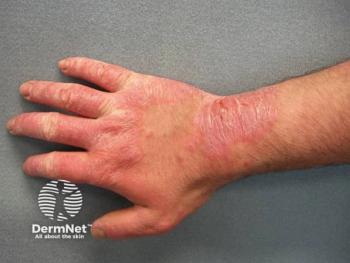
- Dermatology Times, July 2025 (Vol. 46. No. 07)
- Volume 46
- Issue 07
Photoprotection During Pregnancy: Clinical Guidance for Dermatologic Care
Key Takeaways
- Pregnancy-induced hormonal changes increase melanin production, causing hyperpigmentation and heightened UV sensitivity.
- Broad-spectrum, mineral-based sunscreens with iron oxide tints are recommended for safe photoprotection during pregnancy.
For pregnant women, formulations with niacinamide, vitamin E, hyaluronic acid, and peptides may help support barrier function and reduce pigmentation without compromising safety.
Pregnancy induces significant hormonal shifts, including elevated levels of estrogen, progesterone, and melanocyte-stimulating hormone, which collectively stimulate increased melanin synthesis. This heightened melanogenesis often manifests as hyperpigmentation, presenting as melasma and linea nigra.1 Concurrently, these hormonal changes increase skin sensitivity to UV and visible light (VL) exposure, exacerbating pigmentary alterations and increasing susceptibility to UV-induced skin damage.
Despite well-established benefits of photoprotection in preventing pregnancy-related pigmentation and skin damage, sunscreen usage remains suboptimal among pregnant individuals. Factors such as concerns over product safety, limited awareness, and cosmetic acceptability contribute to low adherence. Tailored photoprotection strategies that prioritize safety and user adherence are therefore essential in this population.
Skin Changes in Pregnancy and UV Sensitivity
A recent review highlights that pregnancy heightens the skin’s response to UV radiation and high-energy VL (HEVL).2 These effects are partly driven by hormonal modulation of melanocyte activity. Melasma in particular is a common and often persistent condition during and after pregnancy, especially among women with darker skin tones (Fitzpatrick phototypes IV-VI).3 These patients are more likely to experience pigmentation from HEVL exposure, which stimulates melanogenesis through the activation of opsin 3 in melanocytes.4 The review also notes that even blue and green light wavelengths can trigger pigmentation in lighter skin phototypes, indicating that VL-induced pigmentation is not limited to darker skin types.5
Patient Populations at Risk
Several patient groups are identified as being at higher risk for UV-induced conditions during pregnancy. These include women with a history of melasma or hyperpigmentation, those with darker skin types, individuals with high outdoor exposure, and patients taking photosensitizing medications.2 Pregnant women living in tropical or high–UV-index regions are also more susceptible. In addition, hormonal fluctuations during pregnancy may worsen acne, rosacea, and inflammatory dermatoses, all of which can be aggravated by UV and HEVL exposure.2
Sunscreen Use and Formulation Considerations
The review recommends the use of broad-spectrum sunscreens with protection against UVB, UVA1, and HEVL. Mineral-based sunscreens containing zinc oxide or titanium dioxide are preferred due to their favorable safety profiles and minimal bioaccumulation and systemic absorption.6 However, cosmetic acceptability remains a concern with these formulations, especially in individuals with darker skin tones. To address this, tinted sunscreens that include iron oxides are recommended.2 These offer both HEVL protection and cosmetic camouflage, thus also improving patient adherence. For patients with lighter skin who may not benefit from current tint options, a combination of nontinted sunscreen and iron oxide–containing makeup is suggested.2
The authors support the use of selected organic filters to improve cosmetic adherence, as these filters have a low risk of systemic absorption and no known endocrine-disrupting effects.2 Filters, such as ethylhexyl triazone, bis-ethylhexyloxyphenol methoxyphenyl triazine, and diethylamino hydroxybenzoyl hexyl benzoate, are considered acceptable when combined with mineral blockers.2
Ingredients to Avoid During Pregnancy
The findings advise against using sunscreens containing oxybenzone, octinoxate (ethylhexyl methoxycinnamate), and 4-methylbenzylidene camphor due to concerns about endocrine disruption during pregnancy.7 Homosalate and octocrylene are flagged as requiring further safety evaluation, and their use should be limited in pregnant patients.2
Nonfilter Additives, Vitamin D, and Folic Acid Considerations
The review authors also note that modern sunscreens commonly include nonfilter ingredients for additional skin benefits. For pregnant women, formulations with niacinamide, vitamin E, hyaluronic acid, and peptides may help support barrier function and reduce pigmentation without compromising safety.2 Products with active ingredients such as retinoids or hydroquinone should be avoided during pregnancy.2
The authors also discuss the interaction among sun exposure, folic acid, and vitamin D. UV radiation can degrade folic acid, which is crucial for fetal neural tube development, while also being necessary for cutaneous synthesis of vitamin D.8 Minimal sun exposure is likely sufficient for maintaining vitamin D levels in most pregnant women, though supplementation may be necessary in cases of deficiency, limited sun exposure, or medication interactions.
Clinical Implications
Routine photoprotection during pregnancy should be emphasized as part of standard dermatologic and prenatal care. Mineral-based sunscreens with iron oxide tint and carefully selected organic filters are good options for safe protection. Educating patients on proper use, including reapplication and adjunctive physical barriers such as hats and sun-protective clothing, is also crucial. Dermatologists should assess skin type, patient concerns, and lifestyle factors when recommending sunscreens to improve outcomes and adherence.
Conclusion
Photoprotection is a critical yet underused strategy for managing pregnancy-associated skin conditions such as melasma and UV-induced hyperpigmentation. Evidence supports the use of broad-spectrum, high-SPF sunscreens—preferably mineral based and tinted with iron oxides—tailored to the needs of pregnant patients. Safety, efficacy, and cosmetic appeal can guide sunscreen selection, with a focus on avoiding ingredients with potential endocrine or teratogenic effects. Regular use of appropriate sunscreen, along with patient education and guidance, can reduce the risk of long-term pigmentation changes during and after pregnancy.
Isabella J. Tan is a third-year medical student at Rutgers Robert Wood Johnson Medical School in New Brunswick, New Jersey.
References
- Zhao L, Fu X, Cheng H. Prevention of melasma during pregnancy: risk factors and photoprotection-focused strategies. Clin Cosmet Investig Dermatol. 2024;17:2301-2310. doi:10.2147/CCID.S488663
- Lim HW, Piquero-Casals J, Schalka S, et al. Photoprotection in pregnancy: addressing safety concerns and optimizing skin health. Front Med (Lausanne). 2025;12:1563369. doi:10.3389/fmed.2025.1563369
- Fukase M, Watanabe N, Yamanouchi K, Tsutsumi S, Nagase S. The change of oxidative stress in maternal blood during pregnancy. Reprod Sci. 2022;29(9):2580-2585. doi:10.1007/s43032-022-00848-8
- Regazzetti C, Sormani L, Debayle D, et al. Melanocytes sense blue light and regulate pigmentation through opsin-3. J Invest Dermatol. 2018;138(1):171-178. doi:10.1016/j.jid.2017.07.833
- Moreiras H, O’Connor C, Bell M, Tobin DJ. Visible light and human skin pigmentation: the importance of skin phototype. Exp Dermatol. 2021;30(9):1324-1331. doi:10.1111/exd.14400
- Schneider SL, Lim HW. A review of inorganic UV filters zinc oxide and titanium dioxide. Photodermatol Photoimmunol Photomed. 2019;35(6):442-446. doi:10.1111/phpp.12439
- Schlumpf M, Cotton B, Conscience M, Haller V, Steinmann B, Lichtensteiger W. In vitro and in vivo estrogenicity of UV screens. Environ Health Perspect. 2001;109(3):239-244. doi:10.1289/ehp.01109239
- Borradale D, Isenring E, Hacker E, Kimlin MG. Exposure to solar ultraviolet radiation is associated with a decreased folate status in women of childbearing age. J Photochem Photobiol B. 2014;131:90-95. doi:10.1016/j.jphotobiol.2014.01.002
Articles in this issue
5 months ago
Dermatology Times July 2025 Print Recap5 months ago
Is AI Transforming Skin Care?5 months ago
The Value of RAD, According to Clinicians5 months ago
A New Canvas for Conversations in DermatologyNewsletter
Like what you’re reading? Subscribe to Dermatology Times for weekly updates on therapies, innovations, and real-world practice tips.



















